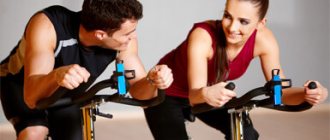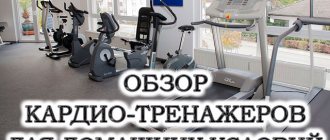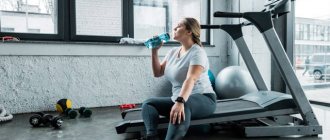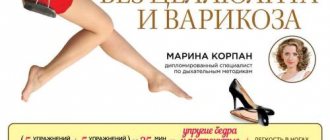Imagine the situation: my son began to disappear after school, periodically shoots money, does not say where and with whom he goes...
Do you think drugs? No! These are symptoms of fitness fever - your baby decided to mold himself into a grown man and went... to the rocking chair! Feel your biceps – is it growing? Fine! However, pulling iron, like everything else in the world, has a downside. Let's look at the pros and cons of teenage experiments with exercise machines.
Andrey Dyshlevich, director of the RusAtlet sports nutrition store, will help us with this .
Young people aged 16-18 experience very rapid growth: bones grow faster than tendons, and muscles even faster than bones. But the fragile “new” muscles and osseous-ligamentous apparatus are quite vulnerable.
It follows from this that all loads must be dosed very strictly. The main task of young people and their coaches is not to overwhelm the body at a young age.
After all, not only is the whole body growing by leaps and bounds, youthful maximalism still lives in the head: at the age of 16, all visitors to the “rocking chair” want to become Schwarzeneggers in a week. Hence the problems: teenagers lift heavy weights, tear tendons and muscles - and it takes a long time to recover.
What does a good coach look like?
Article on the topic
Fitness test. Are you doing it right?
Despite the fact that there are a lot of fitness centers and gyms now, a competent trainer is a rarity. How to distinguish “good” from “bad”?
A competent trainer will at least ask the new visitor for a medical certificate stating whether he is allowed to play sports or not. In addition, the coach should explain to the teenager that bodybuilding is not just pumping iron. To get results, you will have to change your lifestyle.
A good coach should spend the first few training sessions with a young person. Moreover, he is obliged not only to show the technique of performing the exercises, but also to explain how to prepare for classes - how to warm up, warm up the muscles.
As for technique, the coach must ensure that the teenager performs the exercises as correctly as possible, and not in the way that is convenient for him. In the best case, with the wrong technique, the wrong muscles will be pumped up (or nothing will be pumped up at all), and in the worst case, injuries are possible: dislocations, muscle strains, even rupture. In addition, it is very important to perform the exercises correctly from the very beginning, since relearning is much more difficult than mastering from scratch.
And, of course, after assessing the physical condition of the ward, the coach will select the optimal weights and number of repetitions.
Children grow in strength, but not muscle size
Interestingly, strength training in pre-adolescence increases muscle strength without significantly increasing muscle size. This is due to the low production of androgenic hormones in childhood, which are mainly responsible for muscle growth. At the same time, the increase in strength indicators is most likely associated with increased efficiency of the neuromuscular connection and improved coordination of movements. Regular strength training helps transmit nerve signals more efficiently, allowing nerves to recruit more muscle fibers. As a result, strength in children increases significantly, but muscle volume does not increase significantly.
New lifestyle
The results of training are influenced not only by hardware and technique, but also by your entire lifestyle. A young man eager to find a new body needs to sleep at least 8 hours a day, it is vital to give up bad habits (no smoking, no libations), and start eating right. The best eating style is fractional, 5 times a day at intervals of three hours. You can’t “sandwich” 5 times a day either - you have to maintain a balance of proteins, fats and carbohydrates. You shouldn’t expect results from nutrition while running, because 70–80% of success depends on what a bodybuilder eats.
The principle of nutrition is simple: in the morning we load up on slow carbohydrates - these are all kinds of cereals and pasta. Proteins should enter the body in the afternoon, and proteins of animal origin (milk, meat, fish, cottage cheese), as they contain essential amino acids.
And you don’t have to strive to “melt all the fat” - lose weight so that the “pack” on your abs becomes noticeable. Lack of food and excessive exercise can only lead to the body becoming exhausted and exhausted. If you don’t eat, you won’t have muscles - this is a proven fact!
A handsome and muscular male body has always been a sign of strength and masculinity. Therefore, it is not surprising that teenagers are frequent clients in modern gyms. After all, they want to grow up faster, making their body stronger and stronger.
On the one hand, actively playing sports is much better than drinking and smoking in the gateways. However, even in this case, parents begin to panic, because large force loads can damage the health of a teenager. And this is partly the correct conclusion, since constant training with heavy weights, started before the formation of the child’s skeleton is complete, can lead to problems with the musculoskeletal system.
Therefore, in this case, a logical question arises: at what age do you have to go to the gym? In order to answer this, let’s turn to medicine, which clearly states that a child’s skeletal system is formed between the ages of 14 and 16, and at the same time a person’s hormonal levels stabilize.
If you start going to the gym before your bones are properly formed, you can cause irreparable harm to them. And, besides, at this age, the normal male hormonal background has not yet been formed, thanks to which athletes can build muscle mass.
Thus, for children under 14 years of age, it is often simply useless to exercise on strength training equipment, since such training will still not give the desired effect of building muscle mass, and can ruin their health. For this reason, up to the age of 14, it is best to give preference to simply active sports. But you can join fitness using weights only after 16 years.
But still, even at 16, it is undesirable to swing too actively, lifting a lot of weight. You should start training only gradually, and increase the load too. When training, great attention must be paid to the spine, since if the body is positioned incorrectly when performing exercises with weights, posture may be disrupted and curvature of the spine may occur.
Considering the impulsiveness of adolescence, standing alone is fraught with very negative consequences. There is also a very common belief that if you start weightlifting too early, you can pay for it with your height.
But one thing is for sure - starting strength training too early puts a huge and often unreasonable load on children's bones. As a result, a teenager may experience various bone deformities, as well as problems with joints.
It is worth noting, however, that age restrictions apply only to exercises using weights. Therefore, if a child works out in the gym on aerobic machines or does stretching or abdominal exercises, then such training is completely harmless and has a right to happen.
The same applies to other sports, such as various martial arts, gymnastics, running, football and other outdoor games. They can and should be present in a child’s life from a very early age. Some parents send their children to sports clubs from the age of 7. And this is correct, because physical activity will form a good muscular frame and have a positive effect on the child’s health.
Like
Gym and equipment
How to choose a good gym? The recipe is simple: a good coach should work there (and we have already talked about him). There are gyms where people go to hang out - to chat, discuss how their day went. This is nice, but has nothing to do with bodybuilding. If you want to give yourself a new body, look for a gym where people work, sweat, and, as a result, do not distract you from your goals.
As for equipment, you also need to pay attention to it. People come to many gyms to work out in flip-flops. A nightmare! For example, when you squat with a barbell in flip-flops, you run the risk of slipping out of your slippers and being crushed by that very barbell.
However, there is also no point in buying weightlifting shoes - special shoes for powerlifting. The uniform for sports should initially be a training suit with long pants and long sleeves. Being all long makes it easier to warm up your body during warm-ups and keep you warm throughout your workout.
How to properly exercise in the gym for children and teenagers
Sports activities are becoming increasingly popular among children and teenagers. Promoting a healthy lifestyle motivates parents to choose a gym for their children. The benefits of such classes largely depend on the qualifications of the trainer and the specifics of the selected loads.
Exercise equipment for children has a number of specific features. In this article we will analyze age restrictions for training, their impact on the body of children and adolescents. Recommendations from experts will help you understand this topic more deeply.
What loads should I exclude?
Article on the topic
How to choose a sports section for a child? Fitness Expert Tips
It is advisable to exclude from the training processes those loads that act along the axis of the spine, for example, squats with large weights. Heavy weight is the weight of the person himself or more (if a teenager weighs 60 kg, then 60 kg or more is already too much).
Another exercise to avoid is the overhead press. Broad shoulders can be pumped up with the help of other exercises: for example, by doing dumbbell raises.
Avoid heavy weight deadlifts. Many young people will object - they will say nonsense! There are guys who, at 16–18 years old, do 250 kg deadlifts and squats. But we must understand that everyone has different data and different heredity. I believe that it is better to lose a couple of centimeters of biceps at a young age than to undermine your heart, tear a tendon, or cause vertebral displacement.
“If you lift the barbell, you won’t grow”?
Perhaps one of the main misconceptions regarding the compatibility of strength training with childhood is the idea that strength training can delay the growth and development of a child. However, according to the ACSM and the Australian Sports Commission (AIS), recent research shows that in the pre-teen period the epiphyseal plates (growth plates) are not at risk of destruction if training is designed accordingly and the child is under the supervision of a specialist.
ACSM scientists note that physical activity through strength training may actually only help a child's bones grow and strengthen, since most bone formation occurs during childhood.
The perfect workout
- It's better to study at the same time. If a person is a morning person, then the first half of the day is suitable, if a person is an owl, then the evening.
- The optimal training duration is 40–60 minutes. If you exercise more, the effect will be the opposite - the muscles will only become exhausted.
- The workout should be thoughtful, intense, with an equal amount of rest between approaches, without distractions by talking.
- It’s good to practice with a partner - firstly, a partner can always provide backup, and secondly, look from the outside at the technical correctness of performing this or that exercise.
- A person involved in sports should have good rest: 8–9 hours of sleep is a must.
- The optimal frequency of training is 3 times a week. When a person starts exercising, for the first 3 months the body just adapts to the new regime, so don’t let your little one go to the “rocking chair” 7 times a week.
- When purposefully gaining muscle mass, it is worth keeping a diary in which you need to describe what exercises you did, what weights you started with, and what your progress is. You can also make notes about how you feel and regularly show your diary to your trainer. Then later it will be possible to understand whether the training is structured correctly.
At what age can you go to the gym?
According to AIS experts, there are no exact recommendations at what age children can train in a strength style. The American Academy of Pediatrics states that because balance and postural control skills mature to adult levels at approximately 7 to 8 years of age, children should not engage in weight training before this age.
According to ACE, children can begin strength training as early as age 7 or 8 when they demonstrate emotional maturity and are able to clearly understand and follow directions . ACSM scientists emphasize that many, but not all, seven- and eight-year-old boys and girls are able to reap the benefits of strength training. Push-ups, crunches, squats - all these exercises will not cause problems if you perform them with the correct technique and follow the instructions of the trainer.
In general, if children can and want to play football or do gymnastics, then they are ready for some types of strength training. The main goal of strength training for children and teenagers is to increase muscle strength using a variety of safe training methods, and a mandatory component should be that the child has fun.
Sports nutrition
Many parents faint at the word “sports nutrition” and shout a decisive “no!” Don't confuse sports nutrition with steroids. No to steroids! Let's talk about sports nutrition. Unfortunately, with a normal diet, especially in a modern city, the body barely has enough nutrients to maintain life support. And additional muscle growth requires additional protein. It can be obtained from protein shakes. This cocktail is not a terrible horror like an anabolic steroid, but simply purified protein.
If a person who is not involved in sports needs 1 gram of protein per kilogram of weight per day, then those who are trying to build muscle mass need to triple the amount of protein they receive. But protein alone is not enough. When playing sports, the body consumes 2–3 times more vitamins and minerals than during normal life activities. So don't be afraid of dietary and mineral supplements - you need them. Moreover, it is better to use vitamins and mineral complexes for sports, because they contain exactly those substances that are consumed in large quantities during sports.
Mandatory conditions for practicing strength sports
Starting strength training prematurely is dangerous to your health. Those who ignore the danger should take into account that such exercises will not produce any effect. By the time training begins, the following conditions must be met:
The first two conditions limit the age of training from a safety point of view - immature bones and joints are damaged during strength training, and full recovery is likely impossible. Poor physical preparation when starting bodybuilding is the cause of injuries and pain.
The third condition indicates that it is inappropriate to start training before puberty. Growth hormones and testosterone are required for muscle tissue growth. Due to a deficiency of hormones, muscle growth will not occur even with intense training.
Boy with a barbell











